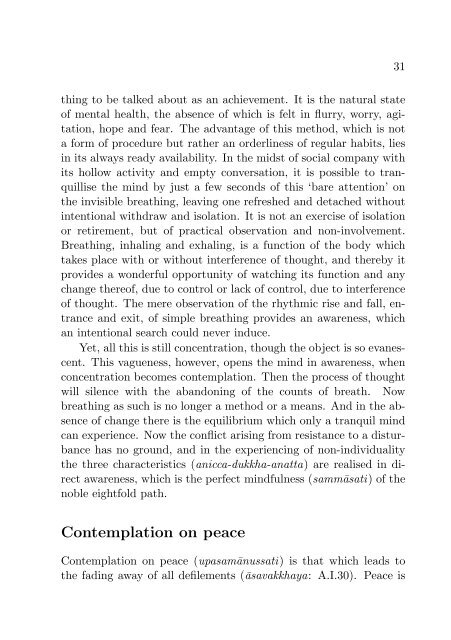Awareness in Buddhist Meditation
A detailed description of awareness in Buddhist Meditation.
A detailed description of awareness in Buddhist Meditation.
Create successful ePaper yourself
Turn your PDF publications into a flip-book with our unique Google optimized e-Paper software.
31<br />
th<strong>in</strong>g to be talked about as an achievement. It is the natural state<br />
of mental health, the absence of which is felt <strong>in</strong> flurry, worry, agitation,<br />
hope and fear. The advantage of this method, which is not<br />
a form of procedure but rather an orderl<strong>in</strong>ess of regular habits, lies<br />
<strong>in</strong> its always ready availability. In the midst of social company with<br />
its hollow activity and empty conversation, it is possible to tranquillise<br />
the m<strong>in</strong>d by just a few seconds of this ‘bare attention’ on<br />
the <strong>in</strong>visible breath<strong>in</strong>g, leav<strong>in</strong>g one refreshed and detached without<br />
<strong>in</strong>tentional withdraw and isolation. It is not an exercise of isolation<br />
or retirement, but of practical observation and non-<strong>in</strong>volvement.<br />
Breath<strong>in</strong>g, <strong>in</strong>hal<strong>in</strong>g and exhal<strong>in</strong>g, is a function of the body which<br />
takes place with or without <strong>in</strong>terference of thought, and thereby it<br />
provides a wonderful opportunity of watch<strong>in</strong>g its function and any<br />
change thereof, due to control or lack of control, due to <strong>in</strong>terference<br />
of thought. The mere observation of the rhythmic rise and fall, entrance<br />
and exit, of simple breath<strong>in</strong>g provides an awareness, which<br />
an <strong>in</strong>tentional search could never <strong>in</strong>duce.<br />
Yet, all this is still concentration, though the object is so evanescent.<br />
This vagueness, however, opens the m<strong>in</strong>d <strong>in</strong> awareness, when<br />
concentration becomes contemplation. Then the process of thought<br />
will silence with the abandon<strong>in</strong>g of the counts of breath. Now<br />
breath<strong>in</strong>g as such is no longer a method or a means. And <strong>in</strong> the absence<br />
of change there is the equilibrium which only a tranquil m<strong>in</strong>d<br />
can experience. Now the conflict aris<strong>in</strong>g from resistance to a disturbance<br />
has no ground, and <strong>in</strong> the experienc<strong>in</strong>g of non-<strong>in</strong>dividuality<br />
the three characteristics (anicca-dukkha-anatta) are realised <strong>in</strong> direct<br />
awareness, which is the perfect m<strong>in</strong>dfulness (sammāsati) of the<br />
noble eightfold path.<br />
Contemplation on peace<br />
Contemplation on peace (upasamānussati) is that which leads to<br />
the fad<strong>in</strong>g away of all defilements (āsavakkhaya: A.I.30). Peace is

















